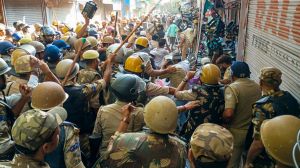Trigger Unhappy
What can 15 handpicked, fairly established, mid-career Indian news photographers learn at a four-day long workshop on photojournalism? Sadly...

What can 15 handpicked, fairly established, mid-career Indian news photographers learn at a four-day long workshop on photojournalism? Sadly enough, the answer is: everything. After a century of print journalism in the country, news photography is still a languishing ancillary. Photojournalism, it seems, is yet to take off in an otherwise media-obsessed nation.
Last week, the Netherlands-based World Press Photo organisation, along with its Indian members like award-winning photojournalist Pablo Bartholomew, conducted a workshop that marked the beginning of the second leg of a three-year programme, in the hope of exposing Indian lensmen to world photography. Their mission, ‘‘to promote free and unrestricted exchange of information and to encourage high professional standards in photojournalism,’’ took off last year when 15 Indian photographers were chosen for the programme. They would be guided by World Press representatives through individual projects.
But, first, why has photojournalism taken a back seat when most other media have taken bold and decisive strides in the field? Is there nothing in the last few decades that stands testament to Indian talent and professionalism? Bartholomew’s answer is a definite ‘‘No.’’ ‘‘There are photographers who have large bodies of work, like Raghubir Singh and Raghu Rai. Otherwise there is nothing like Indian photojournalism,’’ he says.
— Sylvie Rebbot, Picture Editor, Geo France |
This is the general consensus: Barring individuals who have made their mark, the Indian news photographer fraternity is limited.
Notes senior photojournalist Raghu Rai, ‘‘Most of the work that is happening here is directionless. Even pictures of high society parties can be taken to devastating affect, bringing out the madness in people but it is not done because those clients are important.’’
Editorial constraints are a common refrain among photographers. ‘‘We have ideas, but no space to implement them,’’ ‘‘Newspapers concentrate on events not on issues,’’ ‘‘They do not want photos in ad spaces,’’ chorus some participants.
Despite these underlying editorial restrictions that tell on their performance, the matter comes back to individual photographers and their initiative. And this is where Indian news photographers find their weakest link. ‘‘There is no consistency in investigation here,’’ reflects Robert Nickelsberg, a photojournalist who has worked with Time magazine and lived in India for over 11 years. Years of professional experience and his assessment of the Indian photojournalist, compel Nickelsberg to rest the onus largely on the photographer. ‘‘Despite the internal politics of newspapers, you can succeed on merit alone. But you know the short-cut approach in India which plagues every field beginning with the bureaucracy. Photojournalism is a slow and tedious path which no one wants to tread,’’ he adds.
In fact, the lack of dedication and professionalism was reflected in the workshop as well. ‘‘Some of them didn’t even know what their projects were about after a whole year,’’ laments an exhausted Sylvie Rebbot, Picture Editor, GEO France and tutor at the workshop. ‘‘You have to know what you want, at the very least,’’ she states. ‘‘They don’t seem to have given it their best shot,’’ agrees Roger Hutchings, photographer for Network Photographers and tutor at the workshop. ‘‘Their printing was bad, their sense of editing suffers,’’ adds Hutchings, who chaired the jury of the World Press Photo contest this year.
So, has the present workshop helped its participants in any way? ‘‘I have started looking for the story that a picture tells me,’’ says Manish Swarup, of Associated Press. ‘‘There are so many other forms of photography that one can do,’’ says Nilayan Dutta, a freelance photographer from Kolkata. ‘‘Some of the presentations of established photographers like Swapan Parekh were enlightening.’’






- 01
- 02
- 03
- 04
- 05

























